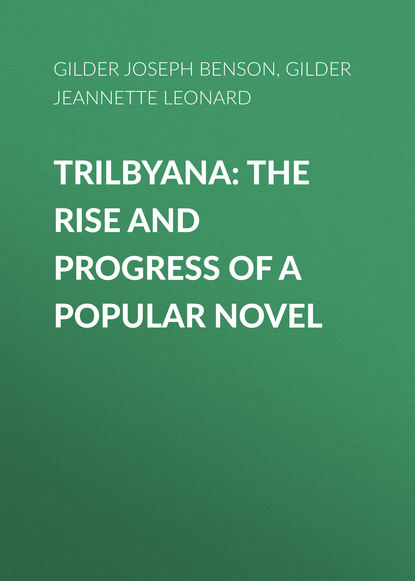По всем вопросам обращайтесь на: info@litportal.ru
(©) 2003-2024.
✖
Trilbyana: The Rise and Progress of a Popular Novel
Настройки чтения
Размер шрифта
Высота строк
Поля
It appears that the first mention of the French book appeared in The Critic, last November. It was in the same month that Mr. Bradford Torrey * * * happened to find a copy of Nodier's "Trilby" in the Boston Athenæum. He took the book to his friend, Mr. J. E. Chamberlin of The Youth's Companion, who began its translation at once. A few days later appeared a note in The Critic from a correspondent in Virginia. Thinking that secrecy was no longer worth while, Mr. Chamberlin wrote his paragraphs for the Transcript "Listener" column, incorporating a bit of translation. This was printed on Dec. 1. Miss Minna C. Smith went to Roberts Bros. at once, to ask them if they would consider the publication of a translation of the romance by her Transcript confrère, and Mr. F. Alcott Pratt replied that they would like very much to see that gentleman's work. Circumstances made Mr. Chamberlin decide not to finish the translation, and he gave Miss Smith his idea and a few pages of the manuscript for a Christmas present. During several weeks following she was engaged upon her careful translation. The Scotch words and names of localities in her manuscript were corrected by Mr. J. Murray Kay of Houghton, Mifflin & Co., an accomplished Scot, who walked through Argyle with his daughters last summer. On March 19, an article on Charles Nodier's story, foreshadowing Miss Smith's translation, appeared in the Transcript. On the morning of March 20, Mr. Dana Estes sent for Mr. Nathan Haskell Dole and asked him to make a translation, which was done with remarkable rapidity, and put out on March 29. Learning of this, Lamson, Wolffe & Co. hurried on Miss Smith's book, which had been in the hands of their printer at the Collins press for days, advertised it on Thursday and brought it out on Saturday, in Scotch plaid covers.
This firm of Lamson, Wolffe & Co., by the way, has just been dissolved for a novel reason. Mr. Wolffe is a member of the class of '95 at Harvard. The publication of "Trilby, the Fairy of Argyle" called the attention of the faculty to his publishing business, and he was asked to give it up, or else forfeit his degree. He chose the former alternative, and although the firm name will remain Lamson, Wolffe & Co., a new and, for the present, silent member of the firm has added capital and scholarship to the house.
* * *
"Trilby, the Fairy of Argyle"
By Charles Noder. 1. Translated from the French, with introduction, by Nathan Haskell Dole. Estes & Lauriat. 2. From the French by Minna Caroline Smith. Boston: Lamson, Wolffe & Co.
Nodier's "Trilby," who now revisits the book-stores owing to Mr. du Maurier's having taken his name for his heroine's, is one of the few latter-day fairies that have fairy blood (or ichor) in their veins. He belongs on the same shelf with Fouqué's "Undine," but, though he was only joking when he personated a father who "had not seen him since the days of King Fergus," he is certainly of the breed of Una and Maer, Caoilte and Mananan. That he made a sensation on his first appearance in the world of letters is shown by Victor Hugo's ode, warning the Fairy of Argyle to beware of ink-slinging penny-a-liners: —
"Car on en veut aux Trilbys
* * * * * * * *
Ils souilleraient d'encre noire,
Hélas! ton manteau de moire,
Ton aigrette de rubis" —
advice which might be repeated apropos of Mr. du Maurier's creation.
Mr. Dole, who has made a translation (1) of Nodier's "Trilby," has looked through all of Scott's novels, he says, to discover, if possible, the "preface or note" from which the French author claimed to have drawn his story, and has the deft art of "Pendennis" and "The Newcomes." And the "Cave of Harmony," with its songs and its bumpers and long whiffs, the gay nights and rollicking days of F. B. and Clive and Pendennis – the glamor of all which has enticed full many a youngster towards the easy descent, or the shining slopes (as the case may be) of art and letters – all these scenes have doubtless served as the studies of the pictures, almost as delightful and masterly as their prototypes, that du Maurier gives us of the joyous Bohemian life of the three jolly Musketeers of the Brush in the Quartier Latin in "Trilby."
Auburn, Ala., 26 Dec., 1894. Charles C. Thach.
* * *
As a small contribution to "Trilbyana," I would call attention to the fact, unnoted so far, that Trilby was the name of Eugénie de Guérin's pet dog, mentioned several times in the journal she kept for her brother Maurice. Was the dog, perhaps, named for the fairy?
Louisville, Ky. A. C. B.
* * *
As there seems to be a mania for hunting up the sources of the inspiration of certain authors, I will engage in the game also. In Saintine's "Picciola," Book I., Chap XII., after the first paragraph, you will find the germ of "Peter Ibbetson."
Grand Rapids, Mich. C. C.
notes
1
See frontispiece.
2
Unless in amended form.





